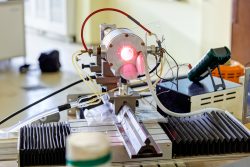 New research from the University of Johannesburg has shown that stem cells from adipose tissue replicate faster when a near-infrared laser is shined on them. A green laser can then be used to transform the stem cells into differentiated cells. These two procedures performed under laboratory conditions resulted in faster proliferation and differentiation.
New research from the University of Johannesburg has shown that stem cells from adipose tissue replicate faster when a near-infrared laser is shined on them. A green laser can then be used to transform the stem cells into differentiated cells. These two procedures performed under laboratory conditions resulted in faster proliferation and differentiation.
When the body is injured, it can repair itself up to a point. Unfortunately some conditions are so severe that healing is limited. Stem cell therapy can help, although the success rate needs to be improved.
Adipose stem cells are found in human fatty tissue. Everyone has these and they can differentiate into most other cell types such as liver, bone, or heart cells to repair the body.
In the study a laser light that shined a specific wavelength on the stem cells was used to stimulate a response. That caused the cells to multiply faster which is called proliferation. Next in order to repair the body, the stem cells need to change into the type of cells needed which is called differentiation.
The researchers found that near-infrared laser light didn’t promote differentiation sufficiently by itself. After shining a green laser light on the stem cells in sequence with the infrared laser there was a 54% increase in proliferation. There was also increased differentiation.
This research was done in the lab using commercial cell lines. Clinical trials on humans using lasers is a few years off.
To view the original scientific study click below:
Single and consecutive application of near-infrared and green irradiation modulates adipose derived stem cell proliferation and affect differentiation factors





